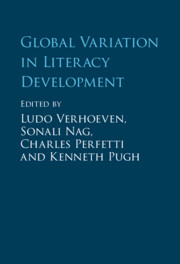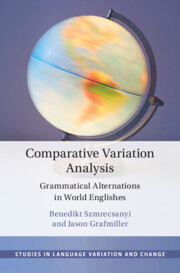162 results
26 - Sociolinguistic Variation in Slavic Languages
- from Part 5 - Sociolinguistic and Geographical Approaches
-
-
- Book:
- The Cambridge Handbook of Slavic Linguistics
- Published online:
- 16 May 2024
- Print publication:
- 23 May 2024, pp 559-583
-
- Chapter
- Export citation
24 - Variation in Gesture: A Sociocultural Linguistic Perspective
- from Part V - Gestures in Relation to Interaction
-
-
- Book:
- The Cambridge Handbook of Gesture Studies
- Published online:
- 01 May 2024
- Print publication:
- 18 April 2024, pp 616-640
-
- Chapter
- Export citation
Chapter 1 - Introduction
-
- Book:
- Intensifiers in Late Modern English
- Published online:
- 15 March 2024
- Print publication:
- 28 March 2024, pp 1-8
-
- Chapter
- Export citation
The embedded Wh- in situ clause: French tout court? Les spasmes musculaires incontrôlés, je sais pas c’est quoi (France Info 20/10/21)
-
- Journal:
- Journal of French Language Studies , First View
- Published online by Cambridge University Press:
- 27 March 2024, pp. 1-33
-
- Article
-
- You have access
- Open access
- HTML
- Export citation
Rhythm in the Kingdom: a variationist analysis of speech rhythm in Tongan English
-
- Journal:
- English Language & Linguistics , First View
- Published online by Cambridge University Press:
- 12 March 2024, pp. 1-23
-
- Article
- Export citation
Variation in the production of Basque ergativity: Change or stable variation?
-
- Journal:
- Language Variation and Change / Volume 36 / Issue 1 / March 2024
- Published online by Cambridge University Press:
- 19 April 2024, pp. 95-120
- Print publication:
- March 2024
-
- Article
-
- You have access
- Open access
- HTML
- Export citation
8 - Literacy and Linguistic Diversity in Multilingual India
- from Part I - Regional Variations
-
-
- Book:
- Global Variation in Literacy Development
- Published online:
- 23 November 2023
- Print publication:
- 07 December 2023, pp 155-173
-
- Chapter
- Export citation
1 - Introduction
-
-
- Book:
- Global Variation in Literacy Development
- Published online:
- 23 November 2023
- Print publication:
- 07 December 2023, pp 1-30
-
- Chapter
- Export citation
20 - Global Literacy
- from Part II - Neurobiological and Ecological Markers
-
-
- Book:
- Global Variation in Literacy Development
- Published online:
- 23 November 2023
- Print publication:
- 07 December 2023, pp 446-468
-
- Chapter
- Export citation
1 - Introduction
-
- Book:
- Time, Metaphor, and Language
- Published online:
- 09 November 2023
- Print publication:
- 23 November 2023, pp 1-7
-
- Chapter
- Export citation

Global Variation in Literacy Development
-
- Published online:
- 23 November 2023
- Print publication:
- 07 December 2023
Epilogue
-
- Book:
- Chinese Politeness
- Published online:
- 02 November 2023
- Print publication:
- 16 November 2023, pp 176-179
-
- Chapter
- Export citation

Chinese Politeness
- Diachrony, Variation, and Universals in Politeness Theory
-
- Published online:
- 02 November 2023
- Print publication:
- 16 November 2023
Pathways to depalatalization of the palatal nasal in Quebec and hexagonal French: An EPG study
-
- Journal:
- Journal of French Language Studies , First View
- Published online by Cambridge University Press:
- 26 October 2023, pp. 1-30
-
- Article
-
- You have access
- Open access
- HTML
- Export citation

Comparative Variation Analysis
- Grammatical Alternations in World Englishes
-
- Published online:
- 24 August 2023
- Print publication:
- 07 September 2023
Chapter 20 - ‘Early Latin’ and the Fragments of Atellane Comedy
- from Part IV - Reception
-
-
- Book:
- Early Latin
- Published online:
- 27 July 2023
- Print publication:
- 17 August 2023, pp 411-433
-
- Chapter
- Export citation
‘Practised among the common people’: ‘vulgar’ pronunciations in eighteenth-century pronouncing dictionaries
-
- Journal:
- English Language & Linguistics / Volume 27 / Issue 3 / September 2023
- Published online by Cambridge University Press:
- 14 August 2023, pp. 447-467
-
- Article
- Export citation
17 - Working with a Range of Different Audiences
-
- Book:
- How to Talk Language Science with Everybody
- Published online:
- 17 May 2023
- Print publication:
- 29 June 2023, pp 203-214
-
- Chapter
- Export citation
Chapter 6 - Supporting Mental Model Construction
-
- Book:
- Handbook of Augmented Reality Training Design Principles
- Published online:
- 18 May 2023
- Print publication:
- 01 June 2023, pp 76-90
-
- Chapter
- Export citation
Emerging grammars in contemporary Yoruba phonology
-
- Journal:
- Canadian Journal of Linguistics/Revue canadienne de linguistique / Volume 68 / Issue 2 / June 2023
- Published online by Cambridge University Press:
- 22 May 2023, pp. 250-303
-
- Article
-
- You have access
- Open access
- HTML
- Export citation



